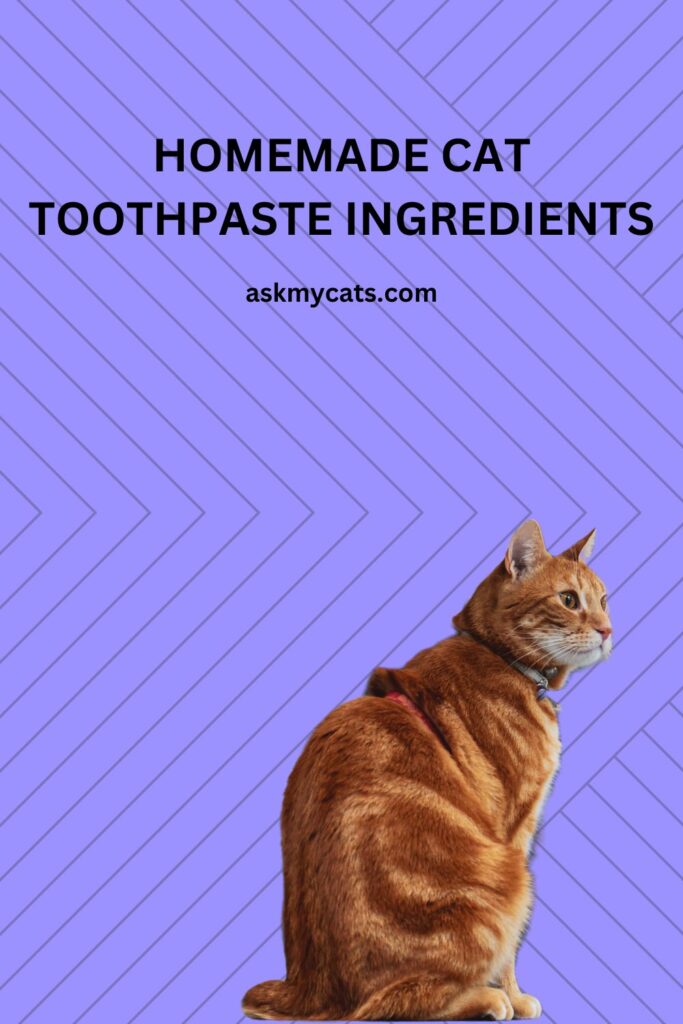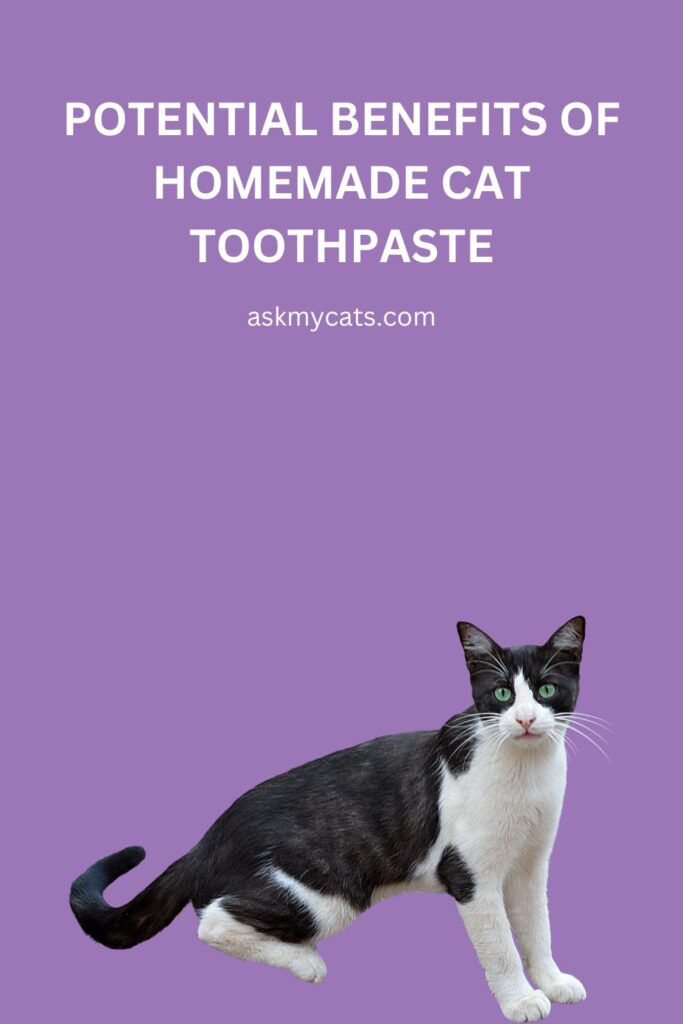While commercial cat toothpaste options abound, a new trend has emerged among cat lovers: homemade cat toothpaste. This innovative approach allows us to take control of our cats’ dental care by crafting personalized toothpaste blends right in our kitchens.
In this article, we will delve into the world of homemade cat toothpaste, exploring the common ingredients used, the potential benefits it offers, and the risks associated with this alternative dental care method.
Key Takeaways
- Ingredients commonly used in homemade toothpaste include baking soda, organic coconut oil, chicken bouillon or flavor enhancer, perio support powder, calcium montmorillonite clay, and dicalcium phosphate anhydrous.
- It’s important to consult with a veterinarian before using homemade toothpaste on your cat to ensure safety and appropriate ratios.
- Benefits of homemade cat toothpaste include cost-effectiveness, personalization, absence of artificial additives, improved dental hygiene, and better overall health.
- Risks associated with homemade cat toothpaste include improper ingredient ratios, the potential toxicity of certain ingredients, the ineffectiveness of improperly formulated toothpaste, and lack of scientific testing or approval.


Give Your Cat the Perfect Day
Get the Free Ebook!
Homemade Cat Toothpaste Ingredients

When it comes to crafting homemade cat toothpaste, several common ingredients have gained popularity among cat owners for their potential oral health benefits.
Here are some key components frequently used in these DIY formulations:
- Baking Soda: Baking soda acts as a gentle abrasive that aids in removing plaque and tartar buildup from your cat’s teeth.
- Organic Coconut Oil: Coconut oil possesses antimicrobial properties that can help combat bacteria in your cat’s mouth. It also helps to bind the other ingredients together.
- Chicken Bouillon or Flavor Enhancer: Adding chicken bouillon or a flavor enhancer can make the toothpaste more palatable for your cat, encouraging them to accept regular tooth brushing.
- Perio Support Powder: Perio support powder is a specialized dental product that contains beneficial ingredients like enzymes, probiotics, and herbs. It is often included in homemade toothpaste recipes to support gum health and maintain oral hygiene.
- Edible Calcium Montmorillonite Clay: Calcium Montmorillonite Clay is a natural substance that can act as an oral cleanser. It helps remove toxins and impurities from your cat’s teeth and gums while providing essential minerals.
- Dicalcium Phosphate Anhydrous: Dicalcium phosphate anhydrous is a polishing agent commonly used in dental care products. It aids in removing surface stains and promoting a brighter smile for your feline companion.
Optional ingredients can be added to enhance the taste and freshness of the toothpaste:
- Stevia Sweetener: Stevia is a natural sweetener that adds a touch of sweetness without contributing to tooth decay. It can make the toothpaste more appealing to your cat’s taste buds.
- Crushed Mint Leaves: Mint leaves can provide a refreshing scent and flavor to the toothpaste, helping to combat unpleasant breath.
Easy Homemade Cat Toothpaste Recipe

Here’s a step-by-step guide and recipe to make homemade toothpaste for cats:
Step 1: Gather the necessary ingredients:
1 tablespoon baking soda
1 tablespoon organic coconut oil
1 teaspoon chicken bouillon or flavor enhancer (optional)
1/2 teaspoon perio support powder (optional)
1/2 teaspoon edible calcium montmorillonite clay (optional)
1/4 teaspoon dicalcium phosphate anhydrous (optional)
Stevia sweetener (optional)
Crushed mint leaves (optional)
Step 2: Preparation:
Ensure all the ingredients are safe for feline consumption and do not pose any health risks.
Clean and sanitize all utensils and containers used for making the toothpaste to maintain hygiene.
Step 3: Mixing the ingredients:
In a small bowl, combine the baking soda and coconut oil.
Add the chicken bouillon or flavor enhancer, perio support powder, calcium montmorillonite clay, and dicalcium phosphate anhydrous if using.
Mix all the ingredients thoroughly until a smooth paste-like consistency is achieved.
Step 4: Optional additions:
If desired, add a small amount of stevia sweetener to add a touch of sweetness without contributing to tooth decay.
You can also add crushed mint leaves to provide a refreshing scent and flavor to the toothpaste.
Step 5: Storing the toothpaste:
Transfer the toothpaste into an airtight container.
Store the toothpaste in the refrigerator to maintain its freshness and prolong its shelf life.
Check for any signs of spoilage or changes in texture or smell, and discard it if it appears expired.
Step 6: Brushing your cat’s teeth:
Introduce the homemade toothpaste to your cat gradually, allowing them to sniff and taste it.
Use a soft-bristled toothbrush specifically designed for cats or a finger brush.
Gently lift your cat’s lips and brush its teeth using circular motions, focusing on the outer surfaces and along the gum line.
Start with short brushing sessions and gradually increase the duration as your cat becomes more comfortable.
Remember, it’s essential to consult with your veterinarian before using homemade toothpaste on your cat. They can provide guidance, ensure the safety of the ingredients, and recommend appropriate ratios based on your cat’s specific needs and oral health.
Must Read: How to Brush a Cat’s Teeth: Step-by-Step Guide
Potential Benefits of Homemade Cat Toothpaste

1. Cost-effectiveness:
One of the significant advantages of homemade cat toothpaste is its cost-effectiveness. Commercial cat toothpaste products can be quite expensive, especially when considering long-term use.
Making your own toothpaste allows you to save money by utilizing readily available ingredients and household items.
2. Personalization and Customization:
Homemade toothpaste grants you the flexibility to tailor the ingredients to your cat’s preferences and specific needs.
You can experiment with different flavors, textures, and scents to find a toothpaste recipe that your cat finds appealing. This personalization can make tooth brushing a more enjoyable experience for both you and your feline companion.
3. Absence of Artificial Preservatives or Additives:
Many commercial cat toothpaste brands contain artificial preservatives, additives, and flavorings. These additives may be a concern for cats with sensitivities or allergies.
By making homemade toothpaste, you have the assurance of using natural ingredients without any artificial substances that could potentially cause adverse reactions.
4. Improved Dental Hygiene:
Regular use of homemade toothpaste can contribute to improved dental hygiene in cats. The abrasive nature of baking soda helps remove plaque and tartar, promoting healthier teeth and gums.
The antimicrobial properties of ingredients like coconut oil can help reduce harmful bacteria in your cat’s mouth. Additionally, incorporating specialized dental products like perio support powder can aid in maintaining optimal gum health.
By addressing oral hygiene, you can potentially prevent dental issues such as periodontal disease, tooth decay, and bad breath in your feline friend.
5. Better Overall Health:
Oral health is closely linked to a cat’s overall well-being. Poor dental hygiene can lead to various health issues, including infections, pain, and difficulty eating.
By using homemade toothpaste as part of a regular oral care routine, you can contribute to your cat’s improved overall health and quality of life.
Interesting Read: How to Keep Your Cat’s Teeth Clean Without Brushing?
Associated Risks of Homemade Cat Toothpaste
While homemade cat toothpaste can have its benefits, it’s crucial to be aware of the potential risks and exercise caution when preparing and using these DIY formulations.
Here are some important considerations:
1. Proper Ingredient Ratios:
The ratios of ingredients used in homemade cat toothpaste are essential. Using excessive amounts of certain ingredients can lead to imbalances and potential harm to your cat.
For example, an excessive amount of baking soda can be abrasive and may cause damage to the tooth enamel. It’s vital to follow reliable recipes and consult with your veterinarian to ensure the correct proportions of ingredients are used.
2. Potential Toxicity of Certain Ingredients:
Some ingredients commonly found in household or natural products can be toxic to cats. For instance, essential oils, such as tea tree oil or peppermint oil, can be harmful if ingested by cats.
Additionally, sweeteners like xylitol, which is safe for humans, can be toxic to cats. It’s crucial to research and ensure that all the ingredients used in homemade toothpaste are safe for feline consumption.
3. Ineffectiveness of Improperly Formulated Toothpaste:
Homemade toothpaste may not be as effective as commercial options if not properly formulated. Commercial toothpaste brands undergo scientific testing and approval processes to ensure their effectiveness in promoting oral health.
Homemade toothpaste formulations, on the other hand, lack this scientific validation. Without the right combination of ingredients and proper formulation, homemade toothpaste may not provide the desired dental benefits.
4. Lack of Scientific Testing or Approval:
Homemade cat toothpaste recipes have not undergone the rigorous scientific testing and approval processes that commercial products go through.
The safety, efficacy, and long-term effects of homemade toothpaste may not be fully understood or validated. It’s important to keep this in mind and proceed with caution when using homemade toothpaste on your cat.
Interesting Read: What Happens If Your Cat Eats Or Licks Toothpaste?
Best Practices for Using Homemade Cat Toothpaste
1. Consult with a Veterinarian:
Before using homemade toothpaste on your cat, it’s essential to consult with a veterinarian. They can assess your cat’s oral health, provide personalized recommendations, and advise on suitable ingredients and ratios for homemade toothpaste.
Your veterinarian is the best source of guidance to ensure the dental care routine is safe and effective for your cat.
2. Research and Choose Appropriate Ingredients and Ratios:
When preparing homemade cat toothpaste, thorough research is crucial. Look for reputable sources, such as veterinary websites or publications, that provide reliable information on cat-friendly ingredients and appropriate ratios.
Pay attention to potential allergens, toxic substances, and ingredient interactions that could harm your cat. Strive for a well-balanced toothpaste that addresses your cat’s dental needs without causing any adverse effects.
Interesting Read: Home Remedies for Cat Tartar Removal
Frequently Asked Questions
Can I use any toothpaste meant for humans on my cat?
No, it is not recommended to use toothpaste meant for humans on cats. Human toothpaste often contains ingredients that can be harmful or toxic to cats. It’s best to use toothpaste specifically formulated for feline oral care.
Can I add essential oils to homemade cat toothpaste?
No, it’s not recommended to add essential oils to homemade cat toothpaste. Some essential oils can be toxic to cats if ingested. It’s safer to avoid using essential oils in toothpaste preparations for cats.
What should I do if my cat refuses to let me brush their teeth?
If your cat refuses to let you brush their teeth, it’s important not to force the issue. Consult your veterinarian for alternative dental care options, such as dental rinses, dental treats, or professional dental cleanings under anesthesia. They can provide guidance on how to maintain your cat’s oral health without tooth brushing if necessary.
Can homemade cat toothpaste prevent all dental issues?
While homemade toothpaste can contribute to improved dental hygiene, it may not prevent all dental issues on its own. Regular professional dental check-ups and cleanings are still important. Additionally, maintaining a balanced diet and providing appropriate chew toys can help support your cat’s oral health.
How long does homemade cat toothpaste stay fresh?
Homemade cat toothpaste typically has a shorter shelf life compared to commercial options. It’s best to make small batches and store them in an airtight container in the refrigerator. Check for any signs of spoilage or changes in texture or smell, and discard it if it appears expired.
Final Words
While homemade toothpaste offers benefits such as cost savings, personalization, and the absence of artificial additives, it’s important to be aware of the associated risks.
Improper ingredient ratios and the potential toxicity of certain ingredients can pose harm to your cat.
Additionally, homemade toothpaste may not be as rigorously tested or approved as commercial options.
By following best practices, such as consulting with your veterinarian, researching ingredients and ratios, and using proper brushing techniques, you can minimize the risks and maximize the benefits of homemade cat toothpaste.
Regular dental care, including tooth brushing, professional check-ups, and appropriate dental treatments, is essential for promoting your cat’s oral health and overall well-being.
Must Read: Do My Cats Need Different Toothbrushes?
Must Read: Can I Brush My Cat’s Teeth With Human Toothpaste?
